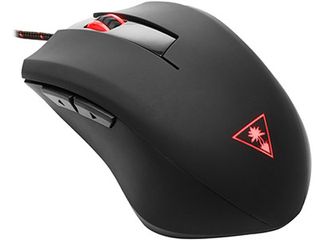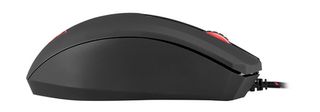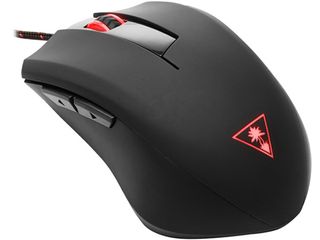Turtle Beach Grip 300 Review — Slow and Steady
The Turtle Beach Grip 300 demonstrates that you don't need a ton of options, fancy software or a high price tag to make a great gaming mouse.
Why you can trust Tom's Guide

Not every gaming mouse needs to be a state-of-the-art powerhouse, packed to the gills with innovative features. In fact, if your tastes skew toward simplicity, that's probably the last thing you want. The Turtle Beach Grip 300 ($40) demonstrates that you don't need a ton of options, fancy software or a high price tag to make a great peripheral; you just need a great design and a firm grasp on your audience.
Design
Elegance, thy name is Grip 300. The mouse is small and black, with red backlighting and a design that leans slightly to the left. (The mouse is for right-handed players only, unfortunately.) There's no thumb rest, per se, although the mouse does jut out to support the thumb.

There's also a groove to rest the two outermost fingers. Neither resting spot has a coarse texture, but they both provide enough friction to prevent sweaty digits from sliding around.
MORE: Best Gaming Mice
One thing to note about the Grip 300 is that it's a surprisingly small mouse. On the one hand, this makes it a good companion for travel on the tournament circuit. On the other hand, the device's small size makes a palm grip more or less impossible. That said, the small peripheral is ideal for gamers with smaller hands, provided that they prefer a claw grip.

The mouse has five buttons altogether: a left button, a right button, a clickable scroll wheel and two thumb buttons. The layout is simple, but effective. The buttons are spaced out evenly, and it's easy to tell the two thumb buttons apart without looking. Innovative, it's not, but it does the job.
Features
The Grip 300's instruction manual boasts that the mouse has no software or special drivers to install, which allows users more time for gaming. This comes with its share of advantages and disadvantages, but generally speaking, I like driverless mice. While it's true that you don't get very granular customization, you also avoid a subpar program that eats up system resources.
That's not to say that the Grip 300 isn't customizable. On the underside of the mouse, there are two switches: one for the polling rate (how rapidly the mouse communicates with the computer) and one for dots-per-inch (DPI) sensitivity. The polling rate won't matter much for anything but the highest levels of play, but being able to shift the DPI among levels of 500; 1,000; and 1,750 is a useful feature.
Tying DPI rate to a switch on the bottom of the mouse presents a few problems, however. For one thing, it's impossible to change DPI on the fly. If you want to slow down your cursor each time you aim a sniper rifle, for example, you're out of luck.

Similarly, while the DPI settings are ideal for first-person shooters, these settings may not suit other genres perfectly. Real-time strategies and multiplayer online battle arenas, for example, tend to work best between 1,200 and 1,500 DPI; 1,000 and 1,750 are both OK, but not perfect. If you want to play massively multiplayer online games with a multi-monitor setup, you're out of luck.
The thumb buttons may also throw users for a loop, depending on the game. While most games allow you to assign commands to the thumb buttons, not every title allows every action on these controls. (StarCraft II, for example, does not allow you to map the useful attack-move command without third-party peripheral software.) Assigning commands to the thumb buttons for everyday productivity programs can also be a chore.
Performance
I tested the Grip 300 with Quake Live, StarCraft II: Heart of the Swarm, Torchlight II and Star Wars: The Old Republic to see how the mouse measured up in-game.
Among the first-person shooter, real-time strategy, action/role-playing and massively multiplayer online games, respectively, the Grip 300 easily performed best with the FPS. In Quake Live, I had a blast running and gunning, and even mapped my weapon-switch functionality to the thumb buttons. I found the DPI settings matched my playstyle perfectly, and the mouse was comfortable, even when my palm perspired.
As mentioned above, the DPI settings are not ideal for RTS or RPG titles in which you need to scroll across the screen constantly, but "not ideal" hardly equates to "terrible." I had a perfectly good time playing both Heart of the Swarm and Torchlight II, although not being able to map the attack-move command to a mouse button in the former was, indeed, a pain.
MORE: Best Gaming Keyboards
The Old Republic worked similarly well, and the thumb buttons came in handy for some of my more frequent skills. Since the mouse lacks macro functions, however, you'll need either a gaming keyboard or extremely nimble fingers to get the most out of this genre.
Bottom Line
Turtle Beach is best known for its top-of-the-line headsets. When I heard the company was going to produce a mouse, I fully expected yet another good-enough, me-too product without much to distinguish it from the competition. What I got instead both shocked and delighted me.
The Grip 300 is not a deep mouse, true. It's primarily suited to one grip style and one genre. However, for $40, it's an extremely clean, simple mouse that gets the job done and even goes a little bit above and beyond. If your PC gaming diet is mostly FPS at a nonprofessional level, with occasional forays into other genres, the Grip 300 is a surprisingly good choice.
Sign up to get the BEST of Tom’s Guide direct to your inbox.
Upgrade your life with a daily dose of the biggest tech news, lifestyle hacks and our curated analysis. Be the first to know about cutting-edge gadgets and the hottest deals.
Marshall Honorof is a senior editor for Tom's Guide, overseeing the site's coverage of gaming hardware and software. He comes from a science writing background, having studied paleomammalogy, biological anthropology, and the history of science and technology. After hours, you can find him practicing taekwondo or doing deep dives on classic sci-fi.

